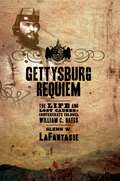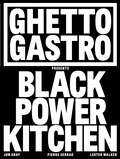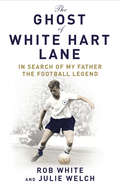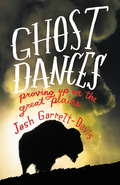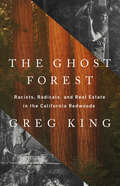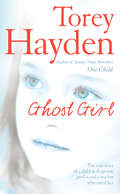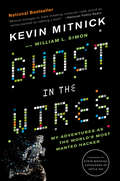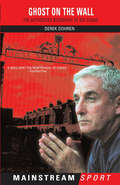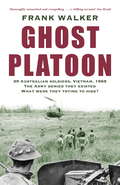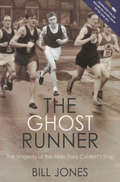- Table View
- List View
Getting to Know Death: A Meditation
by Gail Godwin"Getting to Know Death could just as easily be called Getting to Know Life. As a meditation, it is both unsentimental and full of wonder. As a piece of writing, it stands beside the best of Godwin's fiction. Extraordinary." -Ann PatchettFrom New York Times-bestselling, three-time National Book Award finalist Gail Godwin, a consideration of what makes for a life well lived-for readers of Oliver Sacks's Gratitude and Deborah Levy's Cost of Living.I can't see a way out of this. Things will not necessarily get better. This is my life, but I may not get to do what I want in it.Ingmar Bergman once said that an artist should always have one work between himself and death. When renowned author Gail Godwin tripped and broke her neck while watering the dogwood tree in her garden at age eighty-five, a lifetime of writing and publishing behind her and a half-finished novel in tow, Bergman's idea quickly unfurled in front of her, forcing her to confront a creative life interrupted. In Getting to Know Death, Godwin shares what spoke to her while in a desperate place. Remembering those she has loved and survived, including a brother and father lost to suicide, and finding meaning in the encounters she has with other patients as she heals, she takes stock of a life toward the end of its long graceful arc, finding her path through the words she has written and the people she has loved. At once beautiful, biting, precise, poetic, and propulsive, Getting to Know Death is her own reckoning with the meaning of a life, the forms of passion that guide it, and how the stories we hold can shape our memories and preserve our selves as we write our own endings.
Getting to Zero: A Doctor and a Diplomat on the Ebola Frontline
by Sinead Walsh Oliver JohnsonIn 2014, a 28-year old British doctor found himself co-running the Ebola isolation unit in Sierra Leone's main hospital after the doctor in charge had been killed by the virus. Completely overwhelmed and wrapped in stifling protective suits, he and his team took it in turns to provide care to patients while removing dead bodies from the ward. Against all odds he battled to keep the hospital open, as the queue of sick and dying patients grew every day.Only a few miles down the road the Irish Ambassador and Head of Irish Aid worked relentlessly to rapidly scale up the international response. At a time when entire districts had been quarantined, she travelled around the country, and met with UN agencies, the President and senior ministers so as to be better placed in alerting the world to the catastrophe unfolding in front of her.In this blow-by-blow account, Walsh and Johnson expose the often shocking shortcomings of the humanitarian response to the outbreak, both locally and internationally, and call our attention to the immense courage of those who put their lives on the line every day to contain the disease. Theirs is the definitive account of the fight against an epidemic that shook the world.
Getting to Zero: A Doctor and a Diplomat on the Ebola Frontline
by Sinead Walsh Oliver JohnsonIn 2014, a 28-year old British doctor found himself co-running the Ebola isolation unit in Sierra Leone's main hospital after the doctor in charge had been killed by the virus. Completely overwhelmed and wrapped in stifling protective suits, he and his team took it in turns to provide care to patients while removing dead bodies from the ward. Against all odds he battled to keep the hospital open, as the queue of sick and dying patients grew every day.Only a few miles down the road the Irish Ambassador and Head of Irish Aid worked relentlessly to rapidly scale up the international response. At a time when entire districts had been quarantined, she travelled around the country, and met with UN agencies, the President and senior ministers so as to be better placed in alerting the world to the catastrophe unfolding in front of her.In this blow-by-blow account, Walsh and Johnson expose the often shocking shortcomings of the humanitarian response to the outbreak, both locally and internationally, and call our attention to the immense courage of those who put their lives on the line every day to contain the disease. Theirs is the definitive account of the fight against an epidemic that shook the world.
Gettysburg Requiem: The Life and Lost Causes of Confederate Colonel William C. Oates
by Glenn W. LaFantasieWilliam C. Oates is best remembered as the Confederate officer defeated at Gettysburg's Little Round Top, losing a golden opportunity to turn the Union's flank and win the battle--and perhaps the war. Now, Glenn W. LaFantasie--bestselling author of Twilight at Little Round Top--has written a gripping biography of Oates. Oates was no moonlight-and-magnolias Southerner, as LaFantasie shows. Raised in the hard-scrabble Wiregrass Country of Alabama, he ran away from home as a teenager, roamed through Louisiana and Texas--where he took up card sharking--and finally returned to Alabama, to pull himself up by his bootstraps and become a respected attorney. During the war, he rose to the rank of colonel, served under Stonewall Jackson and Lee, was wounded six times and lost an arm. Returning home, he launched a successful political career, becoming a seven-term congressman and ultimately governor. LaFantasie shows how, for Oates, the war never really ended--he remained devoted to the Lost Cause, and spent the rest of his life waging the political battles of Reconstruction. Here then is a richly evocative story of Southern life before, during, and after the Civil War, based on first-time and exclusive access of family papers and never-before-seen archives.
Gettysburg Requiem: The Life and Lost Causes of Confederate Colonel William C. Oates
by Glenn W. LaFantasieWilliam C. Oates is best remembered as the Confederate officer defeated at Gettysburg's Little Round Top, losing a golden opportunity to turn the Union's flank and win the battle--and perhaps the war. Now, Glenn W. LaFantasie--bestselling author of Twilight at Little Round Top--has written a gripping biography of Oates. Oates was no moonlight-and-magnolias Southerner, as LaFantasie shows. Raised in the hard-scrabble Wiregrass Country of Alabama, he ran away from home as a teenager, roamed through Louisiana and Texas--where he took up card sharking--and finally returned to Alabama, to pull himself up by his bootstraps and become a respected attorney. During the war, he rose to the rank of colonel, served under Stonewall Jackson and Lee, was wounded six times and lost an arm. Returning home, he launched a successful political career, becoming a seven-term congressman and ultimately governor. LaFantasie shows how, for Oates, the war never really ended--he remained devoted to the Lost Cause, and spent the rest of his life waging the political battles of Reconstruction. Here then is a richly evocative story of Southern life before, during, and after the Civil War, based on first-time and exclusive access of family papers and never-before-seen archives.
Ghetto Gastro Presents Black Power Kitchen
by Jon Gray Pierre Serrao Lester Walker Osayi EndolynGhetto Gastro, a Bronx-based creative and culinary collective, delivers a highly visual manifesto for living and eating to stimulate the mind, body, and heart, in a book that promotes Black excellence through recipes, art, and thought-provoking text.
Ghislaine Maxwell: Epstein and the Fall of America's Most Notorious Socialite
by Nigel CawthorneGhislaine Maxwell had everything — model looks, connections, charm, a billionaire father, adoring siblings — yet on 2 July 2020 she was arrested by the FBI on multiple underage-sex charges. Find out the breath-taking real story behind the headlines, programs and documentaries. Her jetset world was not only made up of Presidents, top billionaires, Hollywood stars, Kennedys and Rockefellers, but also of princes, princesses, dukes and duchesses, all as regular friends — including university friend Prince Andrew, the favorite son of the Queen of England. Yet she still wanted more. Ghislaine met shadowy billionaire Jeffrey Epstein and amassed a fortune of almost $30 million over the course of their friendship.
Ghislaine Maxwell: Epstein and America's Most Notorious Socialite
by Nigel CawthorneGhislaine Maxwell had everything — model looks, connections, charm, a billionaire father, adoring siblings, an Oxford education alongside Boris Johnson at Balliol — yet on 2 July 2020 she was arrested by the FBI on multiple underage-sex charges. Find out the breath-taking real story behind the headlines, programs and documentaries, allegations and counter-allegations. Ghislaine's jetset world was not only made up of royalty, dukes and duchesses, — including Prince Andrew —, but also presidents, top billionaires, Hollywood stars, Clintons and Kennedys. Yet she still wanted more. A month after her father's fatal fall from his yacht in 1991, she met shadowy billionaire Jeffrey Epstein and amassed a fortune of several tens of millions over the course of their friendship. Though her $30 million bail was refused, she declined to take a guilty plea ahead of a criminal trial to be held in Manhattan.
The Ghost: In Search of My Father the Football Legend
by Rob White Julie WelchWhen Spurs legend John White was killed by a bolt of lightning in 1964, the football world was rocked by the tragedy. He was just 27 years of age.Nicknamed the 'Ghost' for the way that he could drift into space undetected, White played an inspirational role in the great double-winning Tottenham Hotspur side of the early 1960s. Every fan has a story about him. When White died, his son, Rob, was only six months old and so never knew his father. The man who was revered by hundreds of thousands of football fans across the country was a stranger to him. Beyond the grainy Cup Final footage and yellowed newspaper articles, there was so much Rob didn't know, questions he had never had an opportunity to ask. To find answers he set out to speak to White's former teammates, his family and followers, and built up a touching portrait of a gifted young footballer and of a lost era. 'Had John lived, he could have been one of the greatest footballers of all time' Jimmy GreavesWith a new afterword for the paperback.
Ghost Dances: Proving Up on the Great Plains
by Josh Garrett-DavisGrowing up in South Dakota, Josh Garrett-Davis knew he would leave. But as a young adult, he kept going back -- in dreams and reality and by way of books. With this beautifully written narrative about a seemingly empty but actually rich and complex place, he has reclaimed his childhood, his unusual family, and the Great Plains. Among the subjects and people that bring his Midwestern Plains to life are the destruction and resurgence of the American bison; Native American "Ghost Dancers," who attempted to ward off destruction by supernatural means; the political allegory to be found in The Wonderful Wizard of Oz; and current attempts by ecologists to "rewild" the Plains, complete with cheetahs. Garrett-Davis infuses the narrative with stories of his family as well -- including his great-great-grandparents' twenty-year sojourn in Nebraska as homesteaders and his progressive Methodist cousin Ruth, a missionary in China ousted by Mao's revolution. Ghost Dances is a fluid combination of memoir and history and reportage that reminds us our roots matter.
The Ghost Forest: Racists, Radicals, and Real Estate in the California Redwoods
by Greg KingThe definitive story of the California redwoods, their discovery and their exploitation, as told by an activist who fought to protect their existence against those determined to cut them down. Every year millions of tourists from around the world visit California&’s famous redwoods. Yet few who strain their necks to glimpse the tops of the world&’s tallest trees understand how unlikely it is that these last isolated groves of giant trees still stand at all. In this gripping historical memoir, journalist and famed redwood activist Greg King examines how investors and a growing U.S. economy drove the timber industry to cut down all but 4 percent of the original two-million-acre redwood ecosystem. King first examined redwood logging in the 1980s—as an award-winning reporter. What he found in the woods convinced him to leap the line of neutrality and become an activist dedicated to saving the very last ancient redwood groves remaining in private hands. The land grab began in 1849, when a &“green gold rush&” of migrants came to exploit the legendary redwoods that grew along the Russian River. Several generations later, in 1987, Greg King discovered and named Headwaters Forest—at 3,000 acres the largest ancient redwood habitat remaining outside of parks—and he led the movement to save this grove. After a decade of one of the longest, most dramatic, and violent environmental campaigns in US history, in 1999 the state and federal governments protected Headwaters Forest. The Ghost Forest explores a central question, an overhanging mystery: What was it like, this botanical Elysium that grew only along the Northern California coast, a forest so spectacular—but also uniquely valuable as a cornerstone of American economic growth—that in the end it would inspire life-and-death struggles? Few but loggers and surveyors ever saw such magnificent trees, ancient sentinels that, like ghosts, have informed King&’s understanding of the world. On a lifelong journey, King finds himself through the generations, and through the trees.A Next Big Idea Club Must-Read Title
Ghost Girl: The True Story Of A Child In Desperate Peril And A Teacher Who Saved Her
by Torey HaydenA stunning and poignant account of an extraordinary teacher's determination from the author of the #1 Sunday Times bestsellers The Tiger's Child and One Child.
Ghost Image
by Hervé GuibertGhost Image is made up of sixty-three short essays—meditations, memories, fantasies, and stories bordering on prose poems—and not a single image. Hervé Guibert’s brief, literary rumination on photography was written in response to Roland Barthes’s Camera Lucida, but its deeply personal contents go far beyond that canonical text. Some essays talk of Guibert’s parents and friends, some describe old family photographs and films, and spinning through them all are reflections on remembrance, narcissism, seduction, deception, death, and the phantom images that have been missed. Both a memoir and an exploration of the artistic process, Ghost Image not only reveals Guibert’s particular experience as a gay artist captivated by the transience and physicality of his media and his life, but also his thoughts on the more technical aspects of his vocation. In one essay, Guibert searches through a cardboard box of family portraits for clues—answers, or even questions—about the lives of his parents and more distant relatives. Rifling through vacation snapshots and the autographed images of long-forgotten film stars, Guibert muses, “I don’t even recognize the faces, except occasionally that of an aunt or great-aunt, or the thin, fair face of my mother as a young girl.” In other essays, he explains how he composes his photographs, and how—in writing—he seeks to escape and correct the inherent limits of his technique, to preserve those images lost to his technical failings as a photographer. With strains of Jean Genet and recurring themes that speak to the work of contemporary artists across a range of media, Guibert’s Ghost Image is a beautifully written, melancholic ode to existence and art forms both fleeting and powerful—a unique memoir at the nexus of family, memory, desire, and photography.
Ghost Image
by Hervé GuibertGhost Image is made up of sixty-three short essays—meditations, memories, fantasies, and stories bordering on prose poems—and not a single image. Hervé Guibert’s brief, literary rumination on photography was written in response to Roland Barthes’s Camera Lucida, but its deeply personal contents go far beyond that canonical text. Some essays talk of Guibert’s parents and friends, some describe old family photographs and films, and spinning through them all are reflections on remembrance, narcissism, seduction, deception, death, and the phantom images that have been missed. Both a memoir and an exploration of the artistic process, Ghost Image not only reveals Guibert’s particular experience as a gay artist captivated by the transience and physicality of his media and his life, but also his thoughts on the more technical aspects of his vocation. In one essay, Guibert searches through a cardboard box of family portraits for clues—answers, or even questions—about the lives of his parents and more distant relatives. Rifling through vacation snapshots and the autographed images of long-forgotten film stars, Guibert muses, “I don’t even recognize the faces, except occasionally that of an aunt or great-aunt, or the thin, fair face of my mother as a young girl.” In other essays, he explains how he composes his photographs, and how—in writing—he seeks to escape and correct the inherent limits of his technique, to preserve those images lost to his technical failings as a photographer. With strains of Jean Genet and recurring themes that speak to the work of contemporary artists across a range of media, Guibert’s Ghost Image is a beautifully written, melancholic ode to existence and art forms both fleeting and powerful—a unique memoir at the nexus of family, memory, desire, and photography.
Ghost Image
by Hervé GuibertGhost Image is made up of sixty-three short essays—meditations, memories, fantasies, and stories bordering on prose poems—and not a single image. Hervé Guibert’s brief, literary rumination on photography was written in response to Roland Barthes’s Camera Lucida, but its deeply personal contents go far beyond that canonical text. Some essays talk of Guibert’s parents and friends, some describe old family photographs and films, and spinning through them all are reflections on remembrance, narcissism, seduction, deception, death, and the phantom images that have been missed. Both a memoir and an exploration of the artistic process, Ghost Image not only reveals Guibert’s particular experience as a gay artist captivated by the transience and physicality of his media and his life, but also his thoughts on the more technical aspects of his vocation. In one essay, Guibert searches through a cardboard box of family portraits for clues—answers, or even questions—about the lives of his parents and more distant relatives. Rifling through vacation snapshots and the autographed images of long-forgotten film stars, Guibert muses, “I don’t even recognize the faces, except occasionally that of an aunt or great-aunt, or the thin, fair face of my mother as a young girl.” In other essays, he explains how he composes his photographs, and how—in writing—he seeks to escape and correct the inherent limits of his technique, to preserve those images lost to his technical failings as a photographer. With strains of Jean Genet and recurring themes that speak to the work of contemporary artists across a range of media, Guibert’s Ghost Image is a beautifully written, melancholic ode to existence and art forms both fleeting and powerful—a unique memoir at the nexus of family, memory, desire, and photography.
Ghost Image
by Hervé GuibertGhost Image is made up of sixty-three short essays—meditations, memories, fantasies, and stories bordering on prose poems—and not a single image. Hervé Guibert’s brief, literary rumination on photography was written in response to Roland Barthes’s Camera Lucida, but its deeply personal contents go far beyond that canonical text. Some essays talk of Guibert’s parents and friends, some describe old family photographs and films, and spinning through them all are reflections on remembrance, narcissism, seduction, deception, death, and the phantom images that have been missed. Both a memoir and an exploration of the artistic process, Ghost Image not only reveals Guibert’s particular experience as a gay artist captivated by the transience and physicality of his media and his life, but also his thoughts on the more technical aspects of his vocation. In one essay, Guibert searches through a cardboard box of family portraits for clues—answers, or even questions—about the lives of his parents and more distant relatives. Rifling through vacation snapshots and the autographed images of long-forgotten film stars, Guibert muses, “I don’t even recognize the faces, except occasionally that of an aunt or great-aunt, or the thin, fair face of my mother as a young girl.” In other essays, he explains how he composes his photographs, and how—in writing—he seeks to escape and correct the inherent limits of his technique, to preserve those images lost to his technical failings as a photographer. With strains of Jean Genet and recurring themes that speak to the work of contemporary artists across a range of media, Guibert’s Ghost Image is a beautifully written, melancholic ode to existence and art forms both fleeting and powerful—a unique memoir at the nexus of family, memory, desire, and photography.
Ghost in the Wires: My Adventures as the World's Most Wanted Hacker
by Kevin MitnickThe thrilling memoir of the world's most wanted computer hacker. Kevin Mitnick was the most elusive computer break-in artist in history. He accessed computers and networks at the world's biggest companies -- and no matter how fast the authorities were, Mitnick was faster, sprinting through phone switches, computer systems, and cellular networks. As the FBI's net finally began to tighten, Mitnick went on the run, engaging in an increasingly sophisticated game of hide-and-seek that escalated through false identities, a host of cities, and plenty of close shaves, to an ultimate showdown with the Feds, who would stop at nothing to bring him down. Ghost in the Wires is a thrilling true story of intrigue, suspense, and unbelievable escapes -- and a portrait of a visionary who forced the authorities to rethink the way they pursued him, and forced companies to rethink the way they protect their most sensitive information. "Mitnick manages to make breaking computer code sound as action-packed as robbing a bank." -- NPR
The Ghost of the Executed Engineer: Technology and the Fall of the Soviet Union (Russian Research Center studies ; #No. 87)
by Loren GrahamStalin ordered his execution, but here Peter Palchinsky has the last word. As if rising from an uneasy grave, Palchinsky’s ghost leads us through the miasma of Soviet technology and industry, pointing out the mistakes he condemned in his time, the corruption and collapse he predicted, the ultimate price paid for silencing those who were not afraid to speak out. The story of this visionary engineer’s life and work, as Loren Graham relates it, is also the story of the Soviet Union’s industrial promise and failure. We meet Palchinsky in pre-Revolutionary Russia, immersed in protests against the miserable lot of laborers in the tsarist state, protests destined to echo ironically during the Soviet worker’s paradise. Exiled from the country, pardoned and welcomed back at the outbreak of World War I, the engineer joined the ranks of the Revolutionary government, only to find it no more open to criticism than the previous regime. His turbulent career offers us a window on debates over industrialization. Graham highlights the harsh irrationalities built into the Soviet system—the world’s most inefficient steel mill in Magnitogorsk, the gigantic and ill-conceived hydroelectric plant on the Dnieper River, the infamously cruel and mislocated construction of the White Sea Canal. Time and again, we see the effects of policies that ignore not only the workers’ and consumers’ needs but also sound management and engineering precepts. And we see Palchinsky’s criticism and advice, persistently given, consistently ignored, continue to haunt the Soviet Union right up to its dissolution in 1991. The story of a man whose gifts and character set him in the path of history, The Ghost of the Executed Engineer is also a cautionary tale about the fate of an engineering that disregards social and human issues.
The Ghost of White Hart Lane: In Search of My Father the Football Legend
by Julie Welch Rob White'Had John lived, he could have been one of the greatest footballers of all time' Jimmy GreavesWhen John White was killed by a bolt of lightning in 1964, the football world was rocked by the tragedy. White was just 27 years of age.Nicknamed the 'Ghost' for the way that he could drift into space undetected, White played inside-forward for the great double-winning Tottenham Hotspur side of the early sixties. British football was entering a golden period and Bill Nicholson's free-flowing Spurs side was right at the forefront. White himself was on the cusp of greatness. Even alongside giants of the game like Dave Mackay and Danny Blanchflower, he stood out as a playmaker with incredible vision and touch.White lifted the European Cup Winners' Cup for Spurs (the first European trophy won by any British side) and gained 22 caps for Scotland, but he was also a family man. Six months before he died, his beloved wife Sandra, gave birth to their second child, a son called Rob.Rob White never knew his father. The man who was known by hundreds of thousands of football fans across the country, was a complete stranger to him. The Ghost of White Hart Lane is the result of interviews with his father's teammates, followers, and family members. Within these pages Rob White and Julie Welch have built up a portrait, not only of a brilliant and gifted young man, but also of a lost era.
Ghost on the Wall: The Authorised Biography of Roy Evans (Mainstream Sport Ser. (PDF))
by Derek DohrenGhost on the Wall is the official biography of one of Liverpool Football Club's greatest ever servants: Roy Evans. Born in Bootle in 1948, Evans attracted the attention of many First Division club managers while playing for England's schoolboys team in the early 1960s. In 1964, legendary Liverpool manager Bill Shankly stepped in to sign him. But while the '60s were an exciting time to play for Liverpool, they were also very challenging, and Evans found it hard to break into the first team on a regular basis.Following Shankly's shock resignation in 1974, Evans was given the opportunity to become a member of the backroom staff. It was here that he really made his mark, taking the reserve team to seven Central League titles in nine years and coming of age as a coach and trainer, emerging as an invaluable member of the legendary 'Boot Room'.The decline in the club's fortunes during the 1980s meant that the resignation of manager Graeme Souness in 1994 left the incoming manager facing an exciting challenge - to return the club to its glory days. Roy Evans, 'the last of the Shankly lads', was handed his date with destiny. While the Reds did not win another League Championship under Evans' charge, neither did they finish any lower than fourth, and Evans' commitment to developing future Liverpool stars such as Robbie Fowler, Steve McManaman and Michael Owen ensured that he would not become another 'ghost on the wall' at Anfield.In this engrossing account, Evans reveals the inside story of life as a member of Liverpool's famous Boot Room. He recollects his close working relationships with Reds legends from Shankly to Houllier and provides a vivid portrait of operations at the celebrated club over four action-packed decades.Finally, he discusses the challenges he faces in his new role as assistant manager of the Welsh national side and considers the way forward for Liverpool after their Champions League victory under Rafael Benítez in 2005.
Ghost Platoon (Hachette Military Collection #1)
by Frank Walker'thoroughly researched and compelling . . . a chilling account' - The Sun HeraldAn eye-opening account of Australian combat history, untold . . . until now.In 1969 a ragtag unit of 39 men were thrown together at Nui Dat, Vietnam. It was so slapdash a group it didn't even have an officer or sergeant in charge. A rugged ex-Royal Marine stepped forward to take the lead. Jim Riddle was only an acting corporal but he knew enough of war to keep these young diggers alive.When the platoon was involved in a high-risk ambush Riddle proved his leadership skills, bringing his men through unscathed and leaving the battlefield littered with enemy bodies.Despite their success, immediately afterwards the platoon was disbanded. According to the army they'd never existed – theirs was a ghost platoon.Frank Walker details what happened at that ambush and why the army buried their existence, and the secrets that went with it. His findings are a shocking indictment of the long-term effects of war. The men of the platoon – who'd fought so hard for their country – had to fight again to reveal the truth. But the price they all paid was far too high.Ghost Platoon is a gripping story of the soldiers who should never be forgotten . . . or denied.
The Ghost Runner: The Tragedy of the Man They Couldn't Stop
by Bill JonesThe mystery man threw off his disguise and started to run. Furious stewards gave chase. The crowd roared.A legend was born. Soon the world would know him as 'the ghost runner'. John Tarrant. The extraordinary man whom nobody could stop. As a hapless teenage boxer in the 1950s, he'd been paid £17 expenses. When he wanted to run, he was banned for life. His amateur status had been compromised. Forever. Now he was fighting back, gatecrashing races all over Britain. No number on his shirt. No friends in high places. Soon he would be a record-breaker, one of the greatest long-distance runners the world has ever seen. This is his true story: The Ghost Runner.
Ghosting: A Double Life
by Jennie ErdalGhosting is a remarkable account of one woman's life - or, to be more accurate, lives. For fifteen years, Jennie Erdal had a double existence: officially she worked as a personal editor for one particular man - Tiger - but in reality she was his ghost-writer and in some mysterious sense his alter ego. During this time she wrote a great deal that appeared under his name - from personal letters and business correspondence to newspaper columns, novels and full length books. Ghosting moves from a vivid evocation of an austere upbringing in Fife to superbly rendered portraits of the people with whom Jennie Erdal worked at a London-based publishing house, chief among them Tiger, the larger-than-life character with whom the author had a unique and symbiotic relationship; professionally hidden, yet somehow truthful and intimate. This moving and beautifully written memoir is laced throughout with rich, quiet comedy and profound insights into what it means to be human and to live in language. Ghosting is a meditation on words, identity and creativity, but above all it is a portrait of a uniquely intimate relationship between a man and a woman.
Ghostland: In Search of a Haunted Country
by null Edward ParnellSHORTLISTED FOR THE PEN ACKERLEY PRIZE 2020 ‘A uniquely strange and wonderful work of literature’ Philip Hoare ‘An exciting new voice’ Mark Cocker, author of Crow Country In his late thirties, Edward Parnell found himself trapped in the recurring nightmare of a family tragedy. For comfort, he turned to his bookshelves, back to the ghost stories that obsessed him as a boy, and to the writers through the ages who have attempted to confront what comes after death. In Ghostland, Parnell goes in search of the ‘sequestered places’ of the British Isles, our lonely moors, our moss-covered cemeteries, our stark shores and our folkloric woodlands. He explores how these landscapes conjured and shaped a kaleidoscopic spectrum of literature and cinema, from the ghost stories and weird fiction of M. R. James, Arthur Machen and Algernon Blackwood to the children’s fantasy novels of Alan Garner and Susan Cooper; from W. G. Sebald’s The Rings of Saturn and Graham Swift’s Waterland to the archetypal ‘folk horror’ film The Wicker Man… Ghostland is Parnell’s moving exploration of what has haunted our writers and artists – and what is haunting him. It is a unique and elegiac meditation on grief, memory and longing, and of the redemptive power of stories and nature.
Ghosts By Daylight: A Memoir of War and Love
by Janine Di GiovanniJanine and Bruno first fell in love as young reporters in the besieged city of Sarajevo. Years later - after endless phone calls, much of what the French call malentendu, secret trysts in foreign cities, numerous break-ups, three miscarriages, countless stories of rebel armies and a dozen wars that had passed between them - they arrive in Paris one rainy January to begin a new life together.The remnants of their separate lives, now left behind, are tentatively unpacked into their shared apartment on the Right Bank: Bruno's heavy blanket from Ethiopia, a set of long feathered arrows from Brazil, an ash tray stolen from a hotel in Algeria, and Janine's flak-jacket and canvas boots, still full of sand from the Western Desert in Iraq.But having met in another lifetime - in another world - ordinary, civilian life doesn't come easily. War has become part of them: it had brought them together, and, though both are damaged by it, neither can quite leave it behind. And the difficult journey that follows, through their mix of joy and terror at becoming parents, Bruno's battle with post-traumatic stress and addiction, and Janine's determination to make France her home, leads to an understanding of the truth that people who deeply love each other cannot always live together.A searing, profoundly moving love letter, beautifully written, Ghosts by Daylight is a powerfully raw portrait of marriage and motherhood in the aftermath of war.


